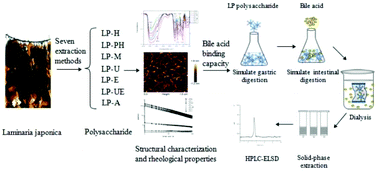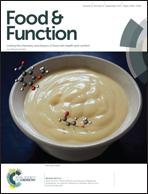A comparison study on polysaccharides extracted from Laminaria japonica using different methods: structural characterization and bile acid-binding capacity
Abstract
In this study, the structural characterization and bile acid-binding capacity of Laminaria japonica polysaccharides (LP), obtained by seven different extraction methods, were investigated. The results indicated that extraction methods exhibited significant effects on extraction yield, molecular weight, monosaccharide composition and the content of neutral sugar, fucose, uronic acid and sulfate of LP. AFM analysis indicated that LP extracted by different methods exhibited certain different, flexible and worm-like chains with many branches. Rheological measurements showed that the LP, obtained by pressurized hot water extraction and acid assisted extraction, exhibited lower viscosity due to their lower molecular weight, compared to other extracted polysaccharides. The bile acid-binding capacity of acid assisted extracted LP was significantly higher than other LP samples tested, which was probably ascribed to its highly branched structure, low molecular weight, low viscosity and abundant uronic acid and fucose in total monosaccharides. The present study provides scientific evidence and advances in the preparation technology and a method for evaluating hypolipidemic activities of L. japonica polysaccharides.



 Please wait while we load your content...
Please wait while we load your content...